Music is the universal language
“Glory to God in the highest heaven, and on earth peace to those on whom his favor rests.” - Luke 2:14
Norse Guitar Feeds
Multi-Instrumentalist, Educator, Session Player Knox Chandler Talks About Collaborations, Artists and Success
By: Rick Landers
One word that helps define multi-instrumentalist, session musician, Knox Chandler, and more is “collaborator”. As a working musician and a superb talent, Chandler has worked with milestone artists that helped form the contours of punk, as well as New Wave music.
Yet, many might be surprised to hear about his music education that required discipline, as well as demanded much more than primal three chord songs. Not only did Knox attend the prestigious Hammonassed School in Madison, Connecticut, but later graduated from Bard College.
Later, he would earn a post-graduate certificate from the University of Sussex, England, at the British Irish Modern Music Institute (BIMM), where his talents were recognized and he was selected to be the head of BIMM’s guitar department.
Chandler has an in-depth and broad career history that includes his collaborative work with many top singer-songwriters, and well-known groups, including: Marianne Faithful, the Psychedelic Furs, R.E.M., Siouxsie and the Banshees, Ultra Vivd Scene, the Creatures, Natalie Merchant, the Golden Palominos, and the legendary Cyndi Lauper. He also was the music arranger for the 2012 music-drama film, Greetings From Tim Buckley.
As a touring musician, Knox Chandler’s worked with the likes of Eric Mingus, Bobby Previte, Chris Palmer, Mars Williams, and Maggie Estep, where his contributions included offering compositions’ support and more on guitar, cello, bass guitar and others.
Guitar International is pleased to present our interview with Knox Chandler, a musician and educator who has successfully explored various music career paths to sustain a career for decades.
******
Rick Landers: Let’s start out with your current projects, as a session player, as well as your own music, then move to your role as an educator.
Knox Chandler: Thanks Rick. I just spent the past few days in New York City and Woodstock working on some new projects.
One is this project resurrecting Tom Verlaine songs and the other was a session for a talented singer songwriter, David Doobinin, produced by Jeff Lipstein. I’m also in the midst of writing and recording a project with The Bush Tetras singer, Cynthia Sley. Very excited about this one.
But lately, most of my time has been spent on the release of my book/album, The Sound (blue elastic records).
This I refer to as a musical memoir documenting the past three years of my transformation from urban life to rural. The shift of my inspiration from streets to streams, after moving back to the USA after living in Berlin, Germany, for ten years.
The book is the tangible product that you can find on my Bandcamp account as well as my website. The music comes with the book in a Bandcamp redeem code or you can listen to it on all streaming platforms. There have been a series of performances supporting this with my live Soundribbons show, which consists of real time soundscapes manipulating the guitar with no pre-existing audio, combined with real time video manipulations.
There have also been some performances supporting Previte Chandler (sub sound records) an album that I wrote and produced with Bobby Previte that came out last February. Then there is Bursting Blue Bone Bark, an ongoing project with Eric Mingus due to be released within the next year.
While living in Berlin I became the head of the guitar department at BIMM University of West Sussex. Through the university I received my post graduate certificate in education.
My main focus was Threshold Concepts using Problem Based Learning Tasks that I had designed. This was a wonderful seven years of not only developing the students’ autonomy, but my own. Since I’ve moved back here (Connecticut) I haven’t had the time to teach in an institution, but i apply these concepts in my own projects, as well as working with others.
Rick: I’ve found that in order to sustain a career in music you have to have a lot or irons in the fire, not only to make life interesting, but to generate multiple revenue streams. Did you start out with some singular notion and later expand or gather up different skills to build your career?
Knox Chandler: It all just fell into place. I started as a guitar player and in college I took up the upright bass. I studied classical and some jazz but leaned more towards experimental music and writing these 12 tone melodies over funk rock jazz beats. I thought that was the direction I would move in after leaving school, but moving to New York City I was getting more attention as a guitarist.
I took up cello right after recording the Book of Days album with The Psychedelic Furs. Richard Butler talked me into it. From there it led to a bunch of cello work as well as string arrangements. I’ve always dabbled in production and arrangement stemming from early days playing around with a Tandberg reel to reel tape recorder.
Rick: How about telling us about how you evolved as a multi-instrumentalist from the early days and are you adding any new instruments to your quiver?
Knox Chandler: Other than what I previously mentioned I enjoy using different instruments as tone generators for my soundribbons. I play around a bit with this pocket trumpet I electrified, as well as banjo, dulcimer and recently a clarinet. Im not good executing any great technique, but the timbre is my focus.
Rick: What’s your go to guitar for sessions, performances and just hanging around the house? I saw a photo of you with a Strat, have you checked out the Fender Strat G5 Roland?
Knox Chandler: My main guitar for most of my career has been this ’59 Strat. It’s really another appendage. Yet, when I was out with Cyndi it was Gretsch (6120 and White Falcon) and Les Paul…sometime some Fenders. Mostly these days i’ve been using a Telecaster with Seymour Duncan antiquities. It all depends on the sound I’m looking for.
It’s Gibson, Fender, Gretsch except a ’70s Herticaster I picked up in Germany. I also play around at home with this wild ’60s/’70s Kent. I’ve gigged twice with it. It’s not very versatile but it has this ONE thing! Probably one of my favourite guitars in my arsenal is my 1930 National Duolian . It’s a clanging tractor of a beast. I drop tune it.
Rick: Do you have any preferences with respect to the “best” construction features for an electric and/or an acoustic? And what guitars do you noodle around with at home?
Knox Chandler: I really don’t have any preference. Some of the cheaper made guitars sound best for what I might want to hear in the moment. I have guitars out all around the house that I just pick up and play, as well as basses. In bed it’s usually always the Kent.
Rick: I’ve spoken to a few guitarists about strings, and one well-known guitarist told me he only changed strings when one broke, and another said he changed his strings every day….What strings do you prefer and do you have any technique to prep new strings?
Knox Chandler: I tend not to like new strings. I usually wait until I can feel the life is sucked out of them, which precedes breaking. I tend to use GHS Boomers 10-46 and I just bend the strings and play.
Rick: You’ve done a lot of session work, so do you have any suggestions for musicians you support as far what they should have ready for session players before stepping into a studio or for virtual work? Any suggestions for what some do that can be frustrating that they should focus on to save time, reduce stress to make a studio session not only productive, but enjoyable?
Knox Chandler: For me, the important thing is that it is always a learning experience. The more you do it, the more you learn. The more you learn the more relaxed you become, which helps with your timing and actually everything. Leave your ego at the door.
Rick: Who have you worked with who surprised you with their creativity or their work ethic/discipline, something that may have also impressed you when you didn’t necessarily expect it?
Knox Chandler: Cyndi Lauper by far was the biggest surprise. In person, her voice is amazing and she works super hard to maintain it. I learned never to take a bunk in the back of the bus because of her 5 am warm down exercises. She works non-stop and is involved with many projects at a time.
I’ve caught her sleeping standing up. She was very creative in the studio making the Shine album. We experimented with all sorts of stuff. Those early days I was with her i was using everything from a Kaoss pad to the Electrix Repeater.
Rick: I found it to be a let down with R.E.M. disbanded, what work did you do with them and what was that project or projects like and are there any particular memories that stand out that made the work uniquely special?
Knox Chandler: I recorded two songs at Bearsville for the Automatic for the People album. They were great to work with. It came from recording “Pink Moon” with Peter Buck and Richard Butler about a year before. Peter called me and said he had come up with a song similar to the cello part I played on “Pink Moon”.
I spent a couple of days at Bearsville then they asked me to go to Atlanta to record with the Orchestra for the John Paul Jones string arrangements.
I had to explain I’m really not a proper cellist. I can’t even read on cello. They put me down as a team leader unbeknownst to me on the contract so when Vanilla Sky had “Sweetness Follows” (R.E.M.) in the film I started getting all this extra money. I actually called up the Secondary Musicians Fund telling them I think they made a mistake . That’s when they told me how generous those guys are.
Rick: Please, tell us about your association with the British Irish Modern Music Institute – I understand you live in Berlin, so are you collaborating with BIMM virtually or do you commute to get the work done? And, tell us about the Institute and how you found your way to that institution.
Knox Chandler: I moved to Berlin mostly because Budgie (Siouxsie & the Banshees) highly suggested it would be a good place for me. He was right. After living there for a couple of years he was approached to teach at BIMM at their new Berlin school. He recommended me for the guitar department. I taught a series of different courses and was the head of the guitar department.
They paid for my extra degree and pretty much gave me a lot of freedom to adjust the curriculum to a more creative aesthetic. I spent all my time at the school until Covid and then it was virtual. Last February, I was back in Berlin for a series of shows and did a workshop at BIMM while there.
Rick: You’ve worked with some top end folks in the music community. What are some of the highlights that you’ve experienced and have you found the genre of music people perform reflects who they are off-stage?
Knox Chandler: Tricky was an amazing experience seeing his creativity working with a sampler. I was already using a sampler at that time but his unorthodox method inspired me. There have been so many, but recording Animus Anima at Siouxsie’s and Budgie’s manor in the south of France stands out as a fantastic way to record. We used all these different rooms and were able to experiment at our freedom.
As far as off stage matching their genre of music scenario, I would say it’s 50/50.
Rick: We’ve all got artists that have inspired us, many who we’d expect to hear about, but are there any obscure artists that have inspired you in some fashion and what about them got your attention?
Knox Chandler: There are so many. Debussy, James Blood Ulmer, Don Cherry, Sun Ra , Mingus, Pete Cosey, Charlie Patton etcetera etcetera. However, when you get to the primal source of a lot musicians you find their inspiration often comes from something other than music.
These days my inspiration comes directly from living in nature, mostly nature connected to bodies of water. The rhythm, timbre, harmony, register have had a profound influence.
Rick: You’ve worked with several artists who’ve made their marks on music, punk, new wave, grunge….What experiences have you looked back on with pride and which ones did you find were just fun to work with and why?
Knox Chandler: I had a lot of fun touring with the Furs and the Banshees and got to experience things I hadn’t before. The Banshees was a challenge that I loved and miss to this day. I put a lot of hard work into the writing and recording of Dave Gahan’s Paper Monsters as well as Maggie Estep’s Love is a Dog from Hell. Both, I am pleased with my work on them. I would say 90 percent of the people I worked with were fun and I learned a lot.
R.E.M. “Sweetness Follows’ with Knox Chandler on Cello.
Rick: I’ve found many creative folks always have far too many ideas for projects and they find it challenging to even get to the start point to get a project, even a dream project out of the starting blocks. What dream projects – that you can divulge – are on your bucket list?
Knox Chandler: I have another project called Sea of Stars that I will put out on my label in the future as well as a Soundribbon record. These projects all come out of a concept usually consisting of a specific liminal space. A lot of the fun is in the design. A dream project would be some futuristic big band/orchestra.
Rick: There are very very talented young musicians in nearly every town and many also have some kind of rock star dream. But, that can be an elusive career goal and the idea of success tends to get redefined as life unfolds good, bad and ugly experiences or challenges. Has your idea of success changed over the years and where are you now with the meaning of it?
Knox Chandler: The business has so changed that a monetary success I have no understanding of. The important thing is one’s intrinsic motivation. What drives you and what do you have to say? You need to have a passion and work very hard. It’s not about money. It has to come from a deeper place in order for it to be sustainable.
Rick: That last question kind of begs the question, you’ve lived a life that many seek or envy…If you could go back and have a conversation with your younger self, what kinds of advice or lessons learned would you convey to yourself?
Knox Chandler: Not to worry so much.
Social Media
Live soundribbons clips
“I take these supplements to stay razor-sharp, night after night”: Yngwie Malmsteen has launched a range of supplement pills and powders

Last year, Swedish virtuoso Yngwie Malmsteen launched his own multivitamin gummies, claiming that vitamins were the true “secret to [his] force”. Now, he’s entered the supplement powders market.
Malmsteen’s new range of supplements ranges from whey isolate protein powder to probiotic pills. There’s also collagen peptides, electrolyte supplements, and watermelon-flavoured pre-workout packed with B1, B2, B3, B6, B12, folic acid, calcium, and a whole host of other ingredients to get you pumped up.
The guitarist shared the news on his Instagram, paired with a short, flashing clip of the supplements that isn’t very epilepsy friendly. “When I’m on stage, there’s no compromise only precision, power, and passion,” Malmsteen writes. “I take these supplements to stay razor-sharp, night after night. This isn’t hype. It’s fuel!”
It’s a similar sentiment to Malmsteen’s initial announcement of his Force gummies: “I am a very busy man that travels the world while playing six shows in a row, up on stage every single night. This works for me so I wanted to make it available for my followers.”
Back in March, Malmsteen explained his decision to dive into the supplements market. “In order for you to be in good health, you need to take supplements,” he explained whilst on SiriusXM’s Trunk Nation with Eddie Trunk. “I’ve always done that. And so the reason I put my line out is because I want other people to do it too. I highly recommend it.”
“I don’t drink, I don’t do drugs,” he continued. “I don’t believe in it… if you wanna do that, go ahead! Be my guest! But I prefer not to do it. And also I think it’s great to let people know: take your vitamins, and it really works.”
As a result of Malmsteen’s health-conscious attitude, his merch website even has its own ‘Supplements Power & Performance’ section. That’s where you can find all of the guitarist’s various supplements – as well as a yoga matt. Fancy holding a downward dog pose to the tune of Rising Force, anyone?
To find out more about the supplements, check out Malmsteen’s merch store.
The post “I take these supplements to stay razor-sharp, night after night”: Yngwie Malmsteen has launched a range of supplement pills and powders appeared first on Guitar.com | All Things Guitar.
EarthQuaker Devices Announces the Easy Listening Analog Amp Simulator
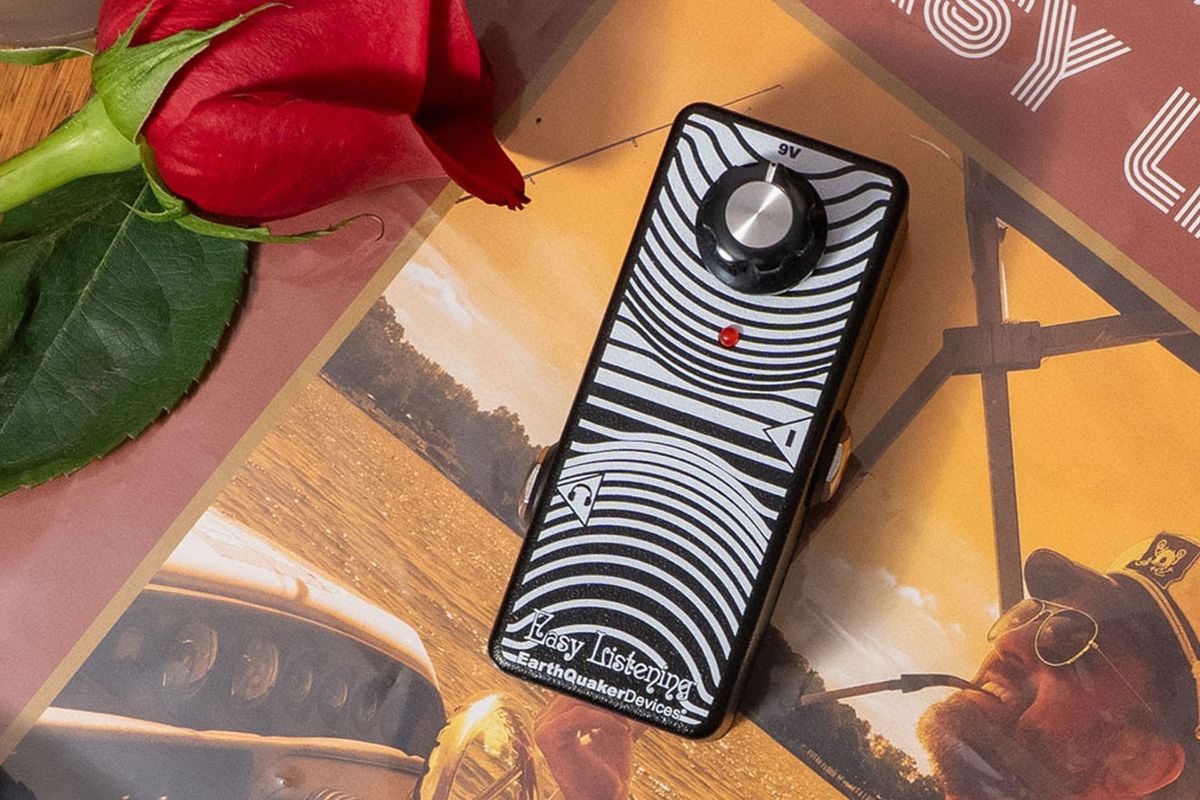
With its finely tuned preamp circuitry and sweet analog cabinet simulation, Easy Listening delivers a big, lush sound with zero latency and no harsh digital artifacts. Think of it as the perfect marriage of vintage tone and modern convenience, offering all the high headroom and low noise of an actual tube amp but small enough to fit in your pocket. No menu diving, no IR loading, and nothing else getting in between you and your tone. Whether you are using this as a headphone amp or the final stage before your recording interface for quick and easy amp-less recording, we think you’ll find this no fuss simulator a delightful addition to your tonal toolbox!
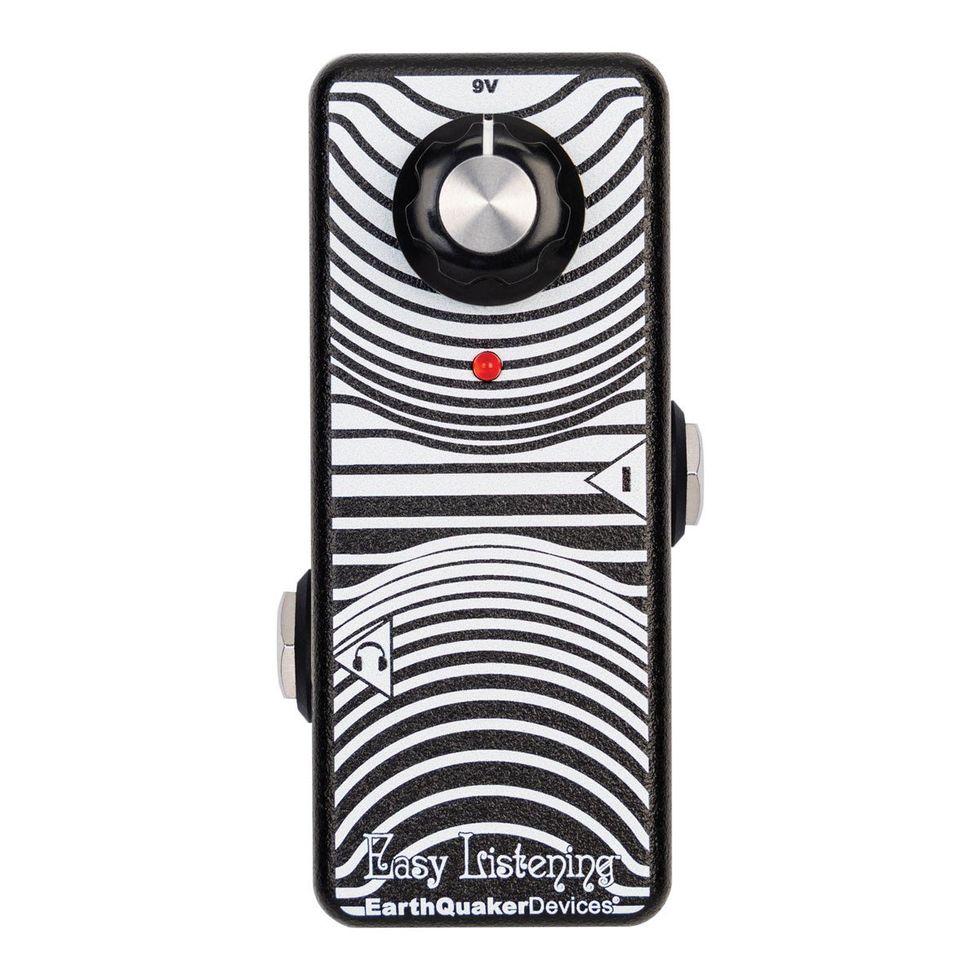
As the name implies, Easy Listening is as simple as it can be to operate, just one control for output volume and that's it. Internally, it's meticulously voiced to capture the soul of one of our favorite classic American guitar amps—a '65 Deluxe—with all the harmonic complexity guitar players crave. Its all-analog circuitry provides a more immediate feel with rich low-end resonance, slightly scooped mids, and that crystalline top end chime that makes electric guitars sing.
Designed with guitarists that use a lot of pedals in mind, Easy Listening features a high 1M input impedance and ample headroom to handle everything from vintage fuzz to modern stacked gain stages without breaking a sweat. The high-fidelity, low-noise analog class AB driver ensures you'll maintain every nuance of your tone at whisper-quiet headphone levels or tracking your sick riffs in your secret basement studio.
Each Easy Listening is built by a powerful robot and a whole bunch of delightful humans in the exotic former rubber capital of the world, Akron, Ohio USA.
Tech Specs:
- Input: Mono TS ¼"
- Output: Stereo TRS ¼" (Tip is the Left channel, Ring is the Right channel)
- Input Impedance: 1 MΩ
- Output Impedance: 39 Ω
- Current Draw: 75 mA
- For use with Headphones: Requires headphones with a ¼" TRS plug.
- For use with a DAW: You can use either a mono TS cable into one channel of your interface or a Stereo TRS cable with a splitter into two channels.
Steve Vai says this guitarist’s cover of And We Are One is “truly outstanding”

Steve Vai has stumbled across an unsung guitar hero who has “nailed” the guitar solo in a cover of his song, And We Are One.
Sharing a clip of the cover to his own Instagram page, Vai has praised the musician – who posts under the name of Tub Guitar – as doing a “truly outstanding” job. Vai feels the solo is one of the best he’s ever composed, so for Tub to receive such high praise from the creator himself is a pretty big deal.
At the time of writing, Tub Guitar has just over 500 followers on his Instagram page (which has been tagged by Vai), and over 1,000 on his YouTube account; numbers which are likely to skyrocket thanks to support from Vai.
The song was released in 2016, and comes from his Modern Primitive album. Tub plays through the song with a Steve Vai signature model no less, and even wears a Steve Vai inspired get-up.
Under the footage of Tub’s cover, Vai writes: “Hey folks, I came across this extraordinary cover of And We Are One by Tub Guitar. I never thought I would ever see anything like this. Frankly, this is one of my favourite solos that I’ve ever done and he just nailed it with all my quirky maneuvers. Seeing someone take the time, patience and passion to recreate something like this put a huge smile on my face and in my heart. Truly outstanding, my deepest appreciation to you ‘TUB’.”
You can check it out below:
In other Vai news, he’s currently still on tour with The SATCHVAI Band. The group, which launched in December last year, marks the first time in their nearly 50-year careers that Joe Satriani and Vai have formed a band of their own.
The project brings together their shared history, as Satriani served as Vai’s guitar teacher when they were teenagers. They remain on their Surfing With The Hydra tour, with shows continuing into early August.
You can find out more about The SATCHVAI Band via their official website, or check out more from the Tub Guitar YouTube channel.
The post Steve Vai says this guitarist’s cover of And We Are One is “truly outstanding” appeared first on Guitar.com | All Things Guitar.
“There were things I wanted to achieve that I wasn't really getting out of those amps”: Why Slash worked with Magnatone on a signature amp after 30 years of playing Marshall stacks
The Ultimate Les Paul: A Deep Dive into the Black Flat-Top Marvel Built for the Man Himself
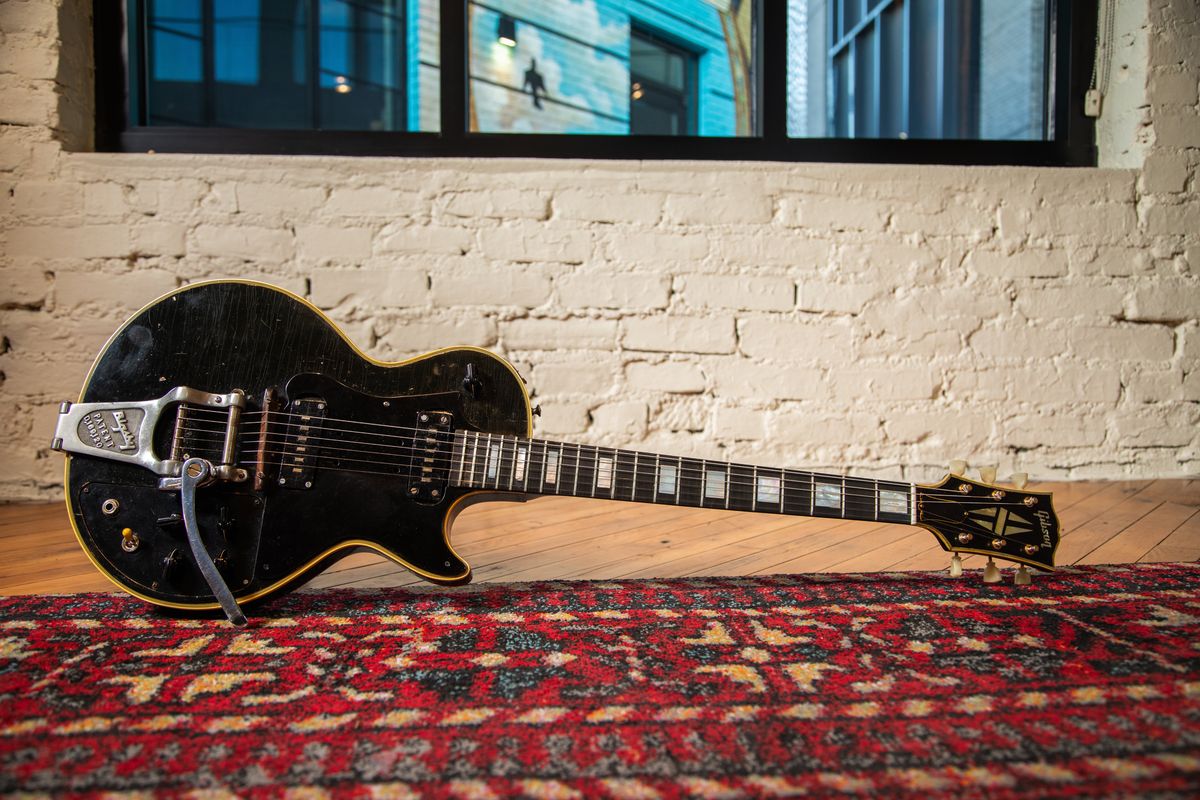
This LP prototype, likely built by Gibson in 1958, is a fascinating piece of the iconic guitar style’s lineage.
In the pantheon of electric guitar legends, few names resonate as powerfully as Les Paul. Not only did he lend his name to one of the most iconic guitars of all time, but he was also a relentless innovator—forever tweaking, refining, and reshaping his tools to chase the elusive perfection of tone. While many collectors and musicians have been captivated by his namesake production models, few have laid eyes on, let alone held, one of the true instruments crafted explicitly for Les Paul himself. This is the story of one such guitar: a custom-built black flat-top Gibson that was part of a rare twin set—crafted to meet the singular standards of a musical genius.
Les Paul’s relationship with the electric guitar wasn’t one of casual use or simple preference. He was a pioneer, deeply immersed in the mechanics of tone and sustain. His work not only revolutionized how guitars were made, but also how they were recorded and performed with. This particular instrument, one of two black flat-tops likely built in 1958 alongside a pair of white counterparts, was a tool in his quest—a quest that combined science, artistry, and an insatiable curiosity.
At first glance, the guitar seems understated. The black finish and flat-top construction suggest minimalism. But closer inspection reveals a level of design and detail that goes far beyond standard factory output. The body—a .25” maple cap atop a solid mahogany core—eschews the arched top and neck binding that many associate with high-end Gibsons of the era. It’s a design born from utility: flatter for increased contact, perhaps for Les’ recording techniques; unbound for ease of modification.
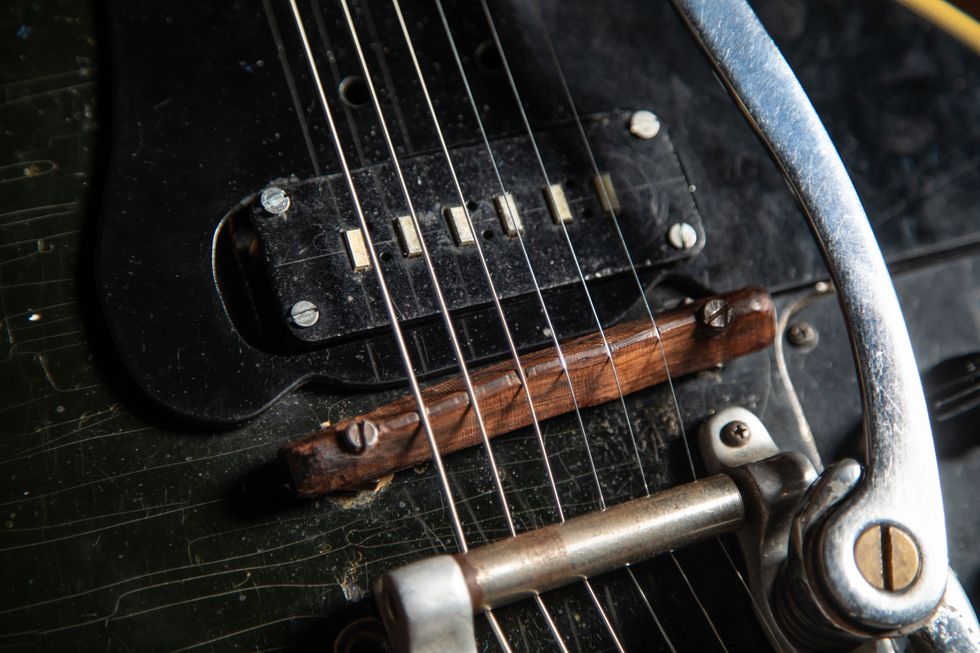
But it’s inside the guitar where things get really interesting. Deep pickup cavities hint at experimentation beneath the surface. The control cavity was uniquely routed for access from both front and rear—an unusual feature likely intended to make electronics swaps and tests easier. The headstock, too, bears the mark of purposeful divergence: elongated with a long taper behind the nut, enhancing string length and tension, possibly for sustain or tonal balance.
And then there are the modifications—refinements so specific they could only come from someone who viewed the guitar not as a finished product, but as a laboratory for sonic discovery. The pickups, Gibson’s low-impedance alnico “staple” style, were either wound by Les himself or by his son Gene. These pickups, with double-tall bobbins and a unique 4-screw mounting system, required a transformer to step up the impedance for direct input to an amp. AIR coils, reverse-wound for hum-cancelling, were mounted beneath the pickguard, beside each pickup. According to Les’ close friend and tech Tom Doyle, Les was using this technique in the late 1940s to get a quieter signal.
“The spirit of the guitar—Les’ spirit—remained intact. It’s not a sterile museum piece, but a living, breathing testament to a life spent chasing sound.”
In terms of playability, Les took matters into his own hands—literally. The neck profile was hand-shaped and refinished in black acrylic. The frets? Low, flat, and re-crowned using nothing more than flat files and emery boards—crude by modern standards, but a testament to Les’ commitment to hands-on craftsmanship. And the bridge? Carved by Les himself from wood, anchored with hefty .25" studs to improve energy transfer and sustain.
Another particularly unique feature is the missing 22nd fret. Removed deliberately, it allowed Les to move the neck pickup further up the body, balancing volume and tone as he climbed the fretboard—a mod unheard of at the time, and one that permanently altered the original pickguard. In true Les fashion, he crafted a new one, hand-shaped and signed on the back. That signature alone would make this guitar historic. The story it tells elevates it to something close to mythic.
Beyond the customizations and features, the guitar bears the marks of its life. It’s a well-played instrument, worn from hours of rehearsal, performance, and experimentation. The original finish has held up remarkably well, with only minor touch-ups. The neck, however, wears its black paint like a badge of honor—proof of Les’ own hand at work. A headstock break in the mid-1960s forced its early retirement from Les’ regular use. Yet even in its dormancy, it remained significant.
In 1974, the guitar changed hands through a trade, eventually resting in the possession of its most recent owner, Les’ friend and sound man Geoff Gray. It sat in storage for decades until its restoration began in 1998. The headstock was professionally repaired, and components like tuners, pots, and Bigsby were replaced with period-correct parts wherever possible. Importantly, the spirit of the guitar—Les’ spirit—remained intact. It’s not a sterile museum piece, but a living, breathing testament to a life spent chasing sound.
This guitar, with its unique blend of factory precision and raw, personal modification, represents the closest one can get to stepping inside Les Paul’s creative process. It’s not just a player’s guitar. It’s not just a collector’s trophy. It’s a physical manifestation of innovation. A rare portal into the mind of a man who changed the course of music history.
Offered most recently by Carter Vintage Guitars in Nashville for a cool $950,000, the guitar has since been sold. But its story continues to echo—a tone that, like Les himself, refuses to fade.
SOURCES: Carter Vintage Guitar interview with Geoff Gray, personal letter from Tom Doyle, October 2024.
Jackson Expands Its Signature Juggernaut Range With Misha Mansoor
Jackson is once again partnering with Misha Mansoor to release three new signature guitars, The Pro Series Signature Misha Mansoor Juggernaut HT6 in Red Crystal and Blue Sparkle and The Pro Plus Series Signature Misha Mansoor Juggernaut ET6 in Riviera Blue. Developed in close partnership with Misha, these Juggernaut metal guitars are built to withstand the demands of Misha’s steadfast and fleet-fingered technique. Perfect for both classic and progressive metal players, these guitars deliver the modern sound that every shredder needs to ignite their tone.
“This refresh came about because every few years we want to see what we can do…these guitars travel around the world and they need to be road ready,” said Misha Mansoor on his new signature guitars. “It’s a no nonsense guitar that looks good, sounds good, and plays good.”
Djent forefather, Misha Mansoor, has gained widespread acclaim as the mastermind behind the axe-centric progressive metal band Periphery. Based in Washington D.C., Periphery is renowned for pushing the limits of progressive metal, using detuned, extended-range instruments to craft a sound that is both technically complex and unapologetically heavy. Misha Mansoor, guitarist and producer, co-founded the band in 2005. With the same precision and innovation that defines Misha's playing, the Juggernaut signature gives players the power to transform their sound.
The premium Juggernaut models feature a 25.5” scale length, poplar body and bolt-on caramelized maple neck with graphite reinforcement, wrap-around heel and oiled back finish for greater playing comfort. With a 20” flat radius ebony fingerboard that features rolled edges, fans can enjoy blazing fast leads. These models feature 24 jumbo stainless steel frets and offset dot inlays. Lastly, the Luminlay
side-dots will guide the guitarist's path even on the darkest of stages, while the heel-mount truss rod adjustment wheel allows for convenient neck relief tweaks.
Misha worked closely, as he did with past models, to develop the exceptional uncovered direct-mount Jackson MM1 pickups. Unwilling to sacrifice tone, these pickups can be shaped with a five-way blade switch, single volume control, and a single tone control with push/pull feature that allows for players to engage or disengage tone options. Designed for articulate heavy picking, the humbuckers deliver a well-balanced sonic range with rich dynamics, intentionally left uncovered to enhance brightness and clarity.
The Pro Plus Series Signature Misha Mansoor Juggernaut ET6 comes equipped with an EverTune F6 Model bridge, engineered to maintain perfect tuning and intonation across the entire neck, even with low tunings. Its counterpart, the Pro Series Signature Misha Mansoor Juggernaut HT6, features a string-through-body hardtail bridge that delivers enhanced sustain, rock-solid tuning stability, and simplified string changes. Both bridges are built to withstand intense playing conditions, providing the unwavering stability essential for Misha's signature heavy metal style.
“We’re beyond thrilled to be partnering with Misha Mansoor on his latest signature guitar collection. His innovation and vision perfectly align with our passion for pushing the boundaries of tone and design,” said Jon Romanowski, VP of Product of Jackson Guitars. “This collaboration reinforces Jackson’s commitment of providing for players who demand nothing but the best.”
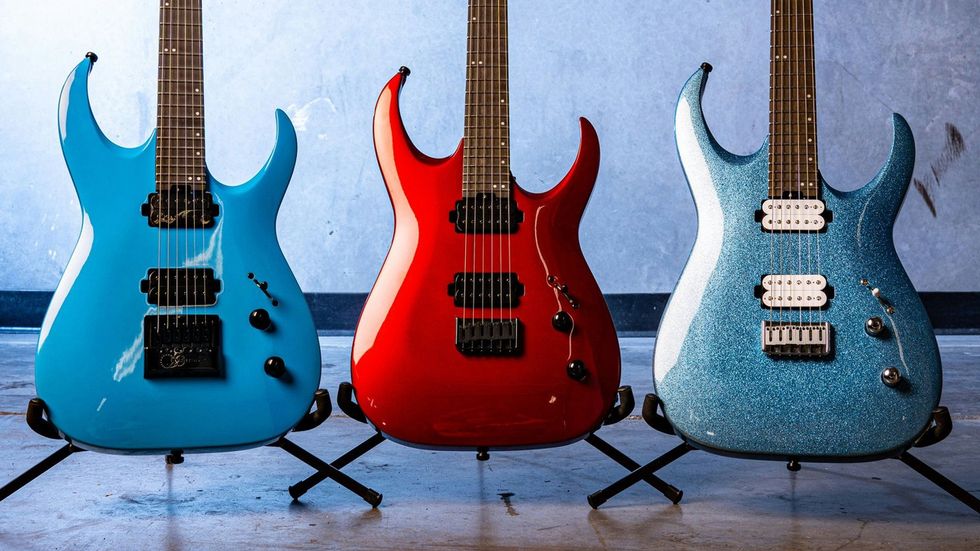
PRO SERIES SIGNATURE MISHA MANSOOR JUGGERNAUT HT6 ($999.99 USD, £949 GBP, €1,149 EUR, $1,899 AUD, ¥165,000 JPY) The Pro Juggernaut HT6 offers a Jackson HT6 string-through-body hardtail bridge, Jackson sealed die-cast locking tuners, Dunlop® dual-locking strap locks and a gig bag. It’s available in Red Crystal or Blue Sparkle with a matching reverse Jackson 3x3 AT-1 headstock.
PRO PLUS SERIES SIGNATURE MISHA MANSOOR JUGGERNAUT ET6 ($1,399.99 USD, £1,399 GBP, €1,649 EUR, $2,599 AUD, ¥231,000 JPY) The Pro Plus Series Signature Misha Mansoor Juggernaut ET6 features an EverTune® F6 Model bridge that will keep your guitar perfectly in tune and intonate all the way up the neck to handle low tunings. This 6-string Juggernaut is wrapped in a statement- making Riviera Blue finish with a color matched reverse Jackson 3x3 AT-1 headstock and black hardware. It also features Dunlop® Dual-locking strap pins for maximum stability.
PRS S2 Special Semi-Hollow Review
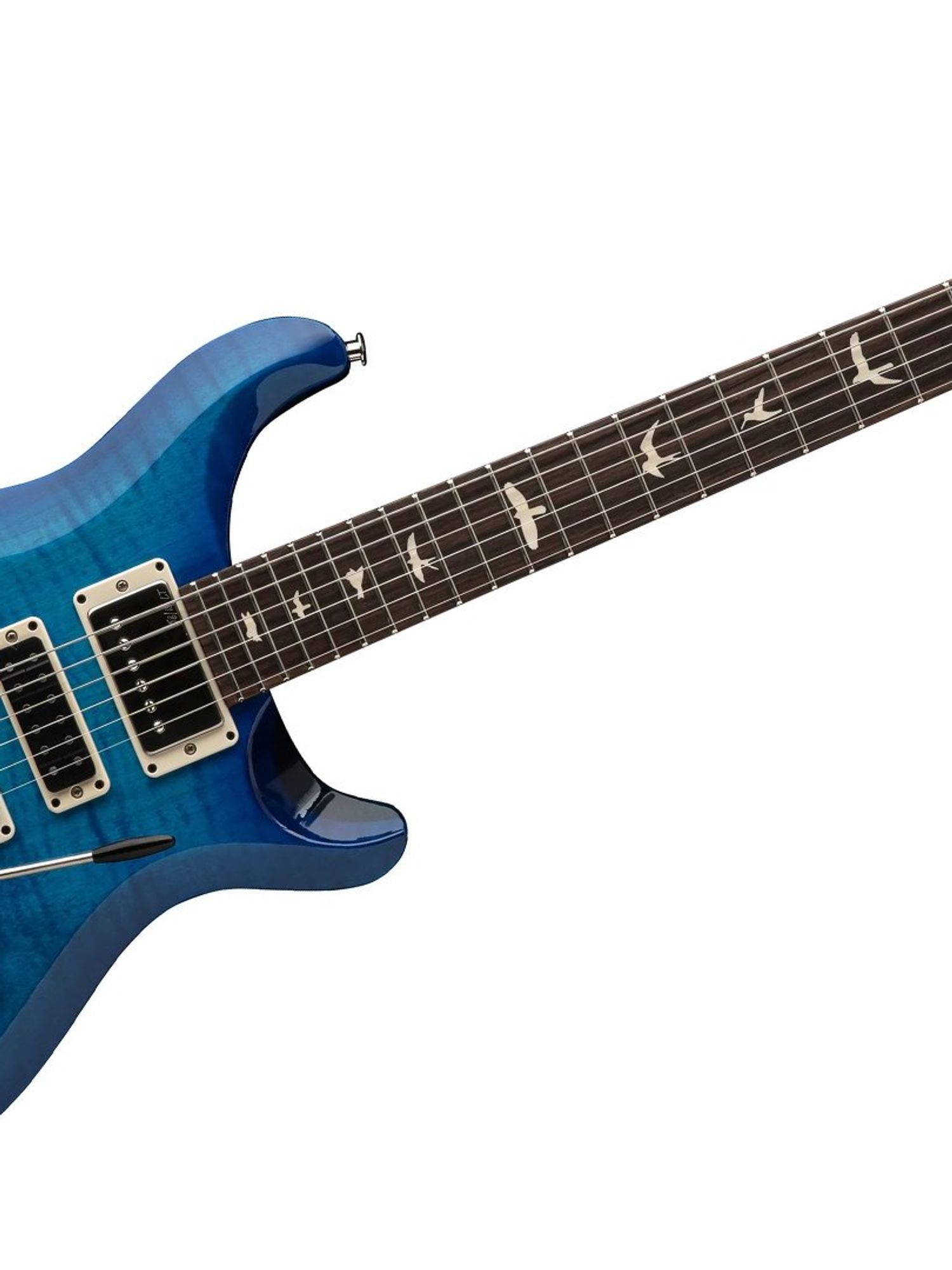
If you’re not well-versed in the structure of PRS’s expansive lineup, the S2 instruments might seem to occupy a curious place in the line. They offer a more affordable path to U.S.-made PRS guitars. But to the uninitiated, the S2 Series can seem nearly as fancy as the Core series in many respects, and the guitars are generally distinguished by less ornate top woods than anything else. When it comes to playability and craft, you’re definitely not sacrificing much. So it goes with this new S2 Special Semi-Hollow.
It’s been just shy of three decades since the first semi-hollow PRS came out, and they remain very appealing and intriguing instruments. The semi-hollow construction offers a truly different voice and feel, and the extra airspace is definitely heard and felt in this new S2 Special Semi-Hollow. It’s built with full-size 58/15 LT humbuckers in the neck and bridge positions , plus a Narrowfield pickup in the middle, which creates a bounty of voices via a 5-way blade switch and coil taps. With a PRS Patented Tremolo and Phase III locking tuners in the mix, the new S2 Special Semi-Hollow is pretty much ready for anything.
Bird Brain
The S2 Special Semi-Hollow is capped by a top made of figured solid maple, with a body fashioned from chambered solid mahogany. It features an asymmetrical bevel around its edges rather than the gently arched top of violin-carve PRS models. That’s a cost-saving element, but it also makes its own stylistic statement and may well lend something unique to the guitar’s voice in certain situations. The chambering brings the otherwise beefy construction in at around 7.4 pounds (a spec that’s likely to vary somewhat from guitar to guitar).
The glued-in mahogany neck is topped with a 22-fret rosewood fretboard with traditional PRS bird inlays. It’s carved to the company’s long-standing Pattern Regular profile (more PRS-speak for a rounded C carve that should be comfortable for most hands). Further cost savings are achieved via the scarfed headstock and heel joint. Specs-wise, the neck is built around PRS’s signature dimensions: a 25" scale length, 10" fingerboard radius, and a nut width of 1 21/32", which famously represents a middle ground between Fender and Gibson specs.
PRS applies a high-gloss nitro finish to the model—a brilliant lake blue on our test guitar that really makes the subtly flamed maple top pop. Black amber, dark cherry sunburst, faded gray black purple burst, faded gray black blue burst (say that 10 times fast), and fire red burst are also available, all with either matching or complementary headstocks. The nickel-plated hardware should hold no great surprises for PRS aficionados: the floating PRS Patented Tremolo is one of the smoother and more successful evolutions of the original Fender Stratocaster vibrato concept from 1954, and the Phase III locking tuners are a proven and time-tested component.
Sound View
The S2 Special Semi-Hollow’s sonic capabilities are broad thanks to the complement of electronics, including the three Maryland-made pickups. The popular 58/15 LTs live unmistakably on the vintage PAF-style pickup spectrum. Both have dedicated mini-toggle coil-tap switches, and the front pickup is reversed from the standard orientation, putting the coil with the adjustable poles on the bridge side simply because, as PRS tells us, “We tested the pickups in both orientations and simply preferred it in this setting.”
Between them is a Narrowfield humbucker that’s only used for the Stratocaster-like 2 and 4 positions on the 5-way blade switch, which means you still get the neck-and-bridge combination that many three-pickup guitars leave out. Between the 5-way and the dual mini-toggles, there are 12 pickup selections in total, all governed by master volume and tone controls.
If the S2 is the “stripped-down” entry to PRS’s USA-made guitars, there’s no evidence of it in the fit and finish, which is what we’ve come to expect from PRS. Sure, it lacks the maple faux-binding around the body top and the bound fingerboard that bring the bling to fancier models, and the birds are acrylic rather than mother of pearl or abalone, but it’s all very well put together and is perfectly playable right out of the included gig bag.
Triple Threat
Hooked up to a Tone King Falcon 1x10, a Bassman head and 2x12 cab, and a Fractal FM9 modeler, the S2 Special Semi-Hollow proved flexible and adaptable to many amps and musical styles. Output from the 58/15 LT humbuckers generally walks the line between clarity and articulation in clean and edge-of-breakup tones and the warmth and thickness of vintage-wind humbuckers. With overdrive, they still bite and wail with the same sense of balance, bending to whatever gain and saturation you throw at them without losing their essence.
It’s a truism of sorts that split humbuckers never quite sound like single-coils, but PRS has gone a long way toward rectifying that by adding a resistor between the deleted coil when you throw each pickup’s mini-toggle—leaving a little of the dumped coil-in signal to fatten the tone slightly. The result still might not sound exactly like a good Telecaster or Stratocaster pickup, but it’s an excellent representation of those tones when the songs demand it, and I’m doubtful anyone in the audience will protest the difference at your next gig. The real secret sauce, however, comes from the Narrowfield in the middle position. And although you never hear it on its own, it pairs well with either pickup in full or tapped mode to help nail those funky, scooped, wiry, in-between sounds. While the ability to flick among so many tones is a pleasure, it can feel fiddly jumping between favorite settings on the fly, but that seems like a small price to pay for this much utility.
The Verdict
Top marks are due to PRS for packing so much versatility into the S2 Special Semi-Hollow. Construction quality, fit, and finish are all exceptional as well, and if the contemporary looks and mixed-triple-pickups suit your tastes, the more accessible, if still significant, $2,599 price will represent real value to the right player.
PRS S2 Special Semi-Hollow Electric Guitar - Lake Blue
S2 Special Semi-Hollow, Lake Blue
“This is a compliment and a diss at the same time from f**king Kirk Hammett!”: Tim Henson reacts to Kirk Hammett’s ‘boomer bends’ response

Tim Henson is rather excited that Kirk Hammett has responded to his ‘boomer bends’ comment that he made in 2021.
For those out of the loop this may all sound a little bit perplexing, but in 2021, Henson made a remark during a discussion alongside Tosin Abasi and Misha Mansoor for Rick Beato’s YouTube channel, when he said he avoids “guitar hero” techniques, including big bends that have a “boomer-ish” sound.
Three years on, that comment was then brought up to Hammett in an interview with Rolling Stone Music Now, in which he both praised Henson for his technical ability, but also questioned his opinion on said ‘boomer bend’.
In the interview, which was published in March this year, Hammett said, “I love that, but you know, is he gonna call Eddie Van Halen a boomer guitar player? I really like [Henson’s] style. It’s really unique, and in terms of technique, it’s amazing. But then, it’s the age-old question, how relatable is it? It’s good to listen to like three or four times. Can you really relate? Sometimes people just wanna listen to music and not feel challenged.”
Now, in his own interview with Rolling Stone, Henson is asked if he’s seen Hammett’s thoughts on the remark, and despite the Metallica guitarist’s mixed opinions, he’s pretty stoked to have been acknowledged by him, and even invites him for a beer and a chin wag about guitar.
“I got a Google alert for Polyphia, and I was like, ‘Oh, what’s this with Kirk Hammett?’ I click on it and I started reading and I’m just like, ‘Oh my God. This is a compliment and a diss at the same time from fucking Kirk Hammett!’” Says Henson.
“[Fellow Polyphia guitarist] Scott [LePage] is a Metallica head. Scott’s father is the singer in Kill ‘Em All, which is a Metallica cover band… So Scott got sad. But I was happy because in an interview that Kirk Hammett was doing about Hammett activities and the world of Kirk Hammett, my name was brought up!
“I appreciate that he even has thoughts about it. Kirk, if you are reading this one, thank you for the acknowledgement. You’re a fucking legend. Take us on tour, dude. Please. Seriously, man. Let’s talk about it over a beer, maybe!”
Both Polyphia and Metallica are touring this year – find out more via their respective websites.
The post “This is a compliment and a diss at the same time from f**king Kirk Hammett!”: Tim Henson reacts to Kirk Hammett’s ‘boomer bends’ response appeared first on Guitar.com | All Things Guitar.
“A tribute to the spirit of creativity that defines this city”: Gibson marks 50 years in Nashville with the Les Paul Music City Special

Nashville has been the home of the Gibson guitar for half a century. To celebrate 50 years of its Tennessee guitars, the guitar giant is marking the occasion with the new 50th Anniversary Les Paul Music City Special.
The limited-edition Les Paul Music City Special serves as a sign of how far the company has come over the past five decades. Not only does it honour the company’s time at Music City, it’s also a meeting point of nostalgia and innovation, with a design inspired by Gibson’s 1970s Marauder.
That’s right – despite being classed as a Les Paul, anyone with eyes can spot that its a revival of the Marauder, a guitar beloved by Tool’s Adam Jones and Kiss’’ Paul Stanley.
While the dual humbucker set-up is certainly more in-line with the Les Paul, but there’s no denying its a re-vamped Marauder. The pair boast similar bodies, but the Marauder’s panel covers more of the body and has a Flying V-style headstock – the same markings of the Les Paul Music City Special. You could also argue it bares similarities to the S1.
 Credit: Gibson
Credit: Gibson
Available in Tobacco Burst, Wine Red and a classy black Ebony, the Les Paul Music City Special is made up of a poplar body, maple neck with a SlimTaper profile, and a striped ebony fretboard with 22 medium jumbo frets. There’s also chrome hardware, Grover Mini Rotomatic tuners, and a nod to the past with its 70s Tribute humbucker pickups.
 Credit: Gibson
Credit: Gibson
“Marking 50 years of Gibson in Nashville, the limited-edition Music City Special model is a tribute to the spirit of creativity and individuality that defines this city,” Mat Koehler, Vice President of Product at Gibson, explains. “It draws on everything we’ve learned since opening our Gibson USA Craftory and channels it into something new and inspiring to play.”
 Credit: Gibson
Credit: Gibson
“We’re very proud to introduce the Music City Special,” Gibson Master Luthier Jim DeCola chimes in. “It pays homage to the Gibson Marauder of the ’70s as well as the city it is named after. It has been reimagined as a straightforward, yet versatile and functional instrument relevant for today’s working musician.”
Empire Music’s Justin Gentile has already had a hands-on experience with the guitar. A video run-down shows the guitar in action, and it showcases some bright and pleasingly snappy playing.
The Les Paul Music City Special is available now for £1,599, with a limited run of 650 models.
The post “A tribute to the spirit of creativity that defines this city”: Gibson marks 50 years in Nashville with the Les Paul Music City Special appeared first on Guitar.com | All Things Guitar.
“The same when I first saw Prince, it was like, ‘We’re safe’”: Mk.gee was named Eric Clapton’s favorite new guitarist – now he’s making waves with a guest spot on Justin Bieber’s new album
“Mike Peters and Eddie Macdonald had written three stone-cold classics by the time they were 25. They showed amazing maturity in their early songwriting”: Remembering Mike Peters, the late frontman of the Alarm
“This is the way Leo would be building guitars if he were still alive. In our eyes, G&L is more ‘Fender’ than Fender actually is”: How G&L Guitars is carrying on the legacy of Leo Fender
Slash admits that he became “disillusioned” with the sound of his Marshall amps and the consistency of his sound

Slash has revealed why he made the switch to Magnatone amplifiers for the making of his 2024 blues record, Orgy Of The Damned.
The Guns N’ Roses guitarist had been working with Marshall for 30 years when news broke that he’d entered a partnership with the Magnatone brand in 2023. Slash also announced that a signature amp was in the works, which was later released as the SL-100, though he clarified he’d still continue his relationship with Marshall alongside his Magnatone work.
In a new video with the Magnatone brand, he now explains why he made the switch for Orgy Of The Damned, and how he first came to own one thanks to fellow GN’R guitarist, Richard Fortus.
“I sort of gradually made my way to Marshalls. [I] did a lot of trial and error with the different amps, and then I pretty much made my home with Marshall for a lot of years,” he begins [via Ultimate Guitar].
“Over time, I started to get… I don’t know what’s the best word for it, disillusioned, with maybe the consistency of my sound with the Marshall, or whatever it was. There were things I wanted to achieve that I wasn’t really getting out of those amps.
“And then I played a Magnatone one time, just by chance, really. I had one. I think Richard Fortus [GNR guitarist] gave it to me. I went to go do this blues record a couple of years ago, [and] I wasn’t looking for a wall of sound for the blues record. I wanted something that was more like a combo, 50-watt or less type of deal. So, I pulled out all these old combos that I had, and I saw the Magnatone.”
He continues, “I was familiar with them because [ZZ Top’s] Billy Gibbons was using them. So I pulled that in there, and I ended up using it for the whole pre-production process. Out of everything I had, I kept going back to that amp. When we went into the studio, I did the whole record with that amp.”
You can find out more about Slash’s SL-100 and his Purple Python series via the Magnatone website. Slash is still listed as a Marshall endorser on its website, where you can also find out what Marshall gear he’s used across his career.
The post Slash admits that he became “disillusioned” with the sound of his Marshall amps and the consistency of his sound appeared first on Guitar.com | All Things Guitar.
“The warm wash of top-class tone we experienced from both these guitars was impossible to resist”: Fenech VT Camphor Laurel Auditorium and VT Professional Blackwood Dread D78 review
“I love using toy guitars that you have to wrestle with. It adds to the performance – you’re pulling from the instrument”: Dean DeLeo on why his favorite STP songs are the ones he didn’t write, and barging into Allan Holdsworth’s dressing room
“Our MD told us, ‘This is very secret – you cannot tell anyone, but Robert Smith is going to be joining us.’ And I swear to God, I started crying”: The moment Olivia Rodrigo guitarist Arianna Powell found out she’d be playing with a Cure legend
New Danelectro in Metal Flake and Glitter Finishes!
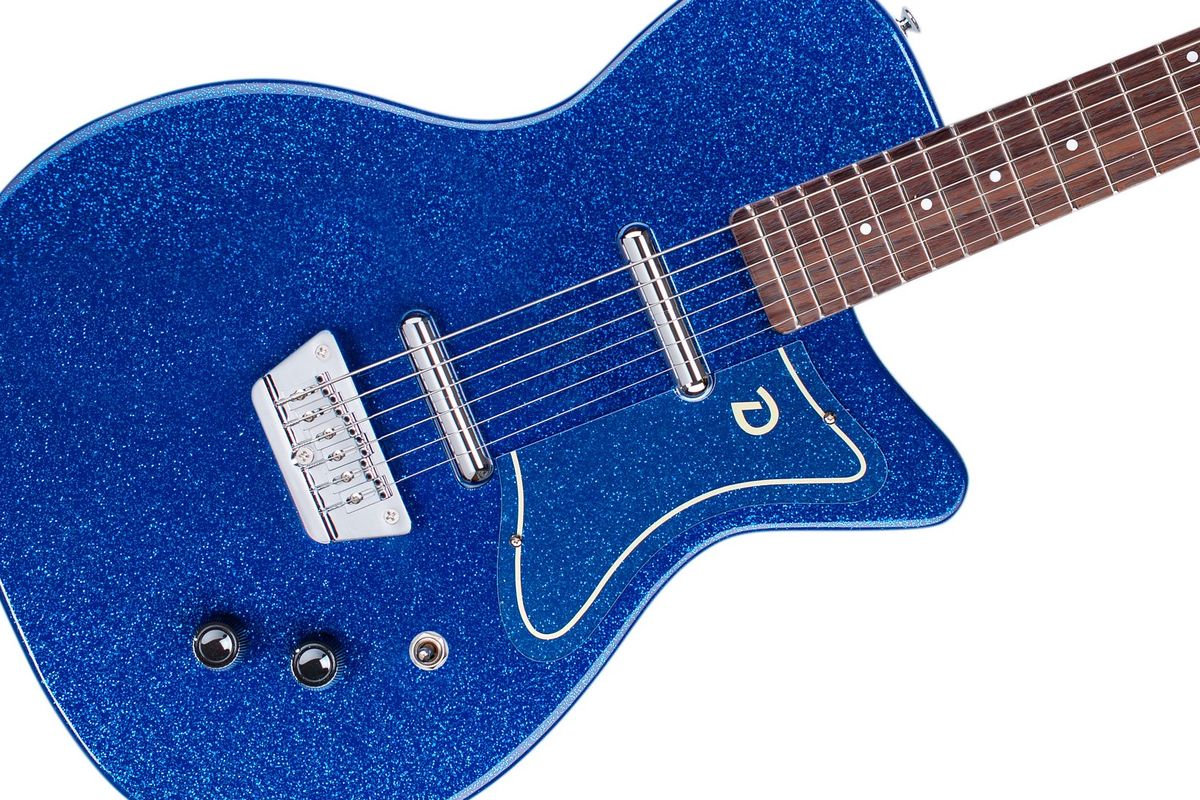
Grab a Dano and step into the spotlight! Adding an eye-catching flair to iconic models, Danelectro has introduced new Metal Flake and Glitter finishes to three of its best sellers.
BIG SITAR
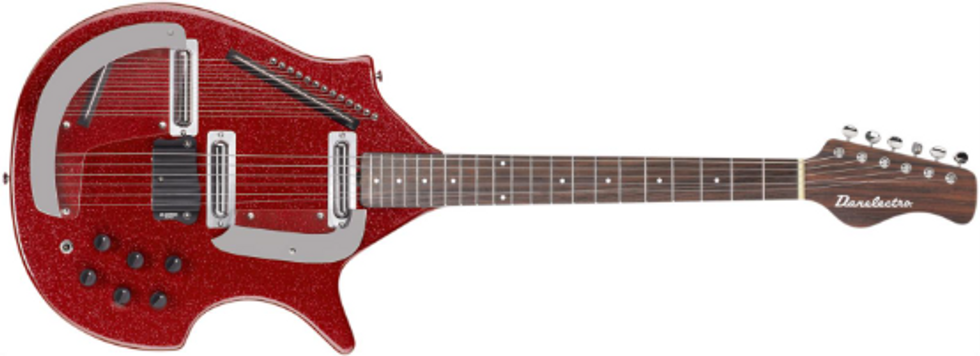
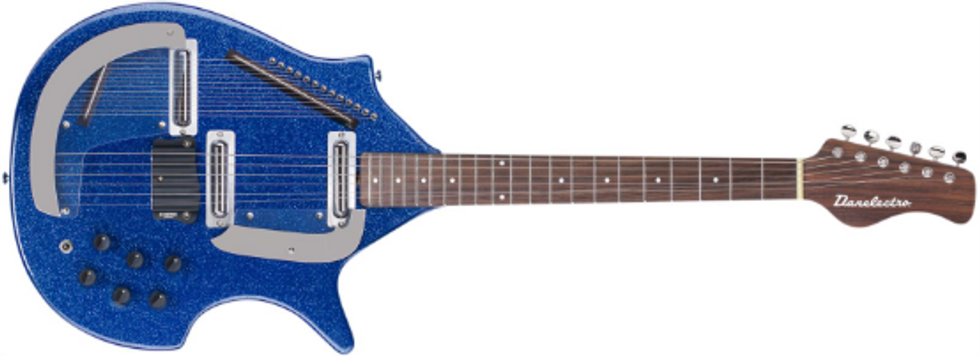 Originally introduced in the 1960s, Danelectro’s Big Sitar appears on thousands of recordings. Its shape is instantly recognizable, as is its sonic imprint: this instrument jumps out in every musical setting! The new Metal Flake models continue the legacy, with 21 frets on a 24.75” scale neck, and three single coil lipstick pickups in the bridge, neck, and mini-harp positions.
Originally introduced in the 1960s, Danelectro’s Big Sitar appears on thousands of recordings. Its shape is instantly recognizable, as is its sonic imprint: this instrument jumps out in every musical setting! The new Metal Flake models continue the legacy, with 21 frets on a 24.75” scale neck, and three single coil lipstick pickups in the bridge, neck, and mini-harp positions.
SINGLE CUT BARITONE

Guitarists and bassists alike have fallen in love with this bari. Its 29.75"-scale neck, two lipstick pickups and B to B tuning hit a sweet spot, both in feel and tone! Now dressed in a great Blue Metal Flake finish, this instrument blends retro appeal – with its “Dolphin” headstock and deco stylings – and spotlight-worthy attitude.
CLASSIC ’59
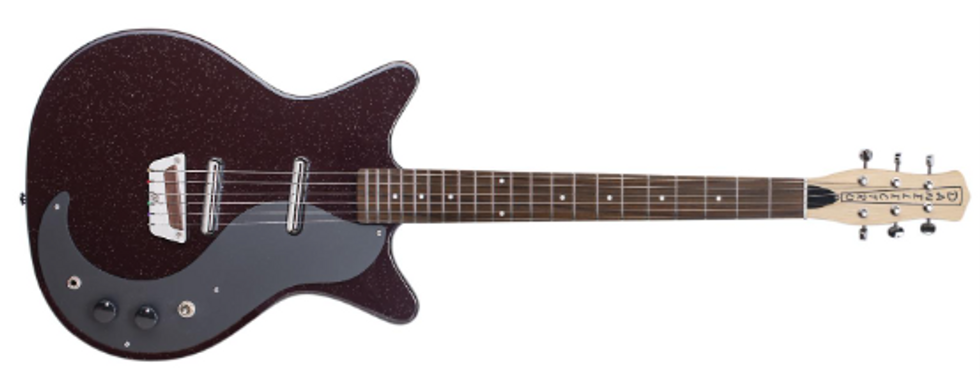
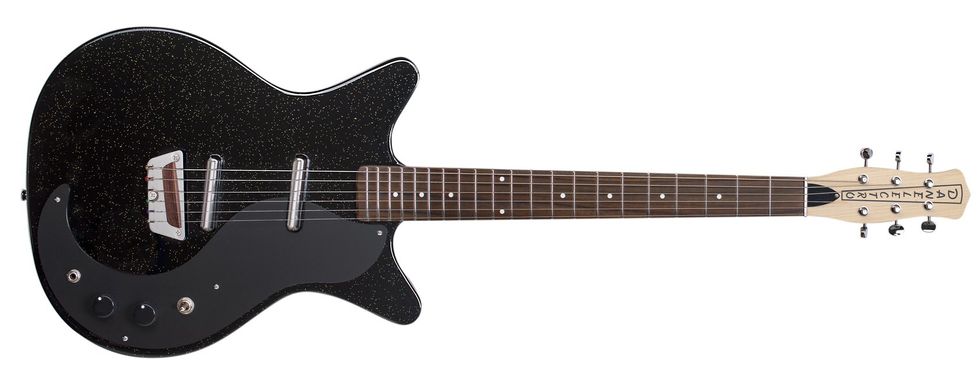
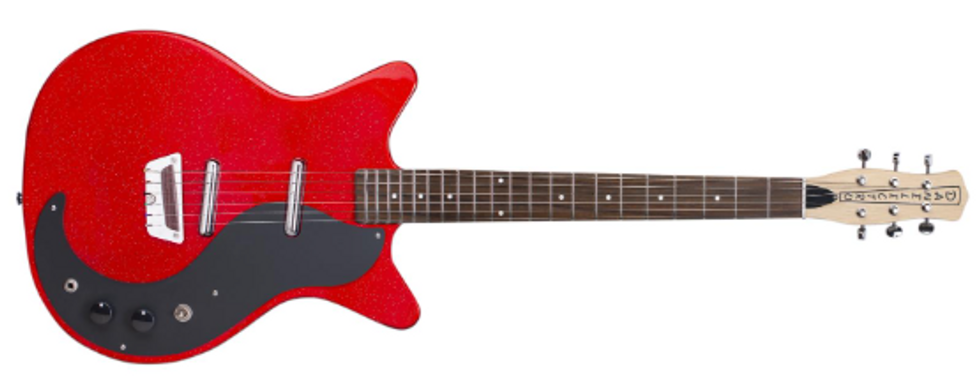
Danelectro’s most famous model gets an ultra-classy treatment with three new finishes, all with black pickguard and black side tape. It’s a perfect complement to the ‘59’s timeless shorthorn shape, “bottle” headstock, 21-fret 25” scale neck and original rosewood saddle bridge. Of course, a pair of lipstick pickups deliver the inimitable Danelectro tone.
For more information visit danelectro.com.
Amp Man’s Guide to Buying a Tube Amp
The longtime author of PG’s popular Ask Amp Man column—and one of the godfathers of the low-power-amp revolution with Budda and then EAST—returns to outline everything you need to know about tracking down the valve-propelled sound machine of your dreams.
In the immortal words of the Byrds:
“So you want to be a rock and roll star? / Then listen now to what I say.
Just get an electric guitar / then take some time and learn how to play.”
But you’re also going to need an amplifier! And if you’re following the Byrds’ protocol, you want a tube amp. These are the amps that voiced all the classic music that made history and still stands the test of time. Finding your ideal tube amp can be a never-ending search, but here are a few tips that may help you get started in your search for tube-amp nirvana.
What do you expect from your amp? Do you want the amp to have a good clean sound as well as the gain you need for solos? If so, then you may want an amp with channel switching, enabling you to footswitch between beautiful clean rhythms and a powerful overdriven solo assault. Some control options to look for here: Does the amp have the ability to alter the tone of the clean and overdrive channels? Sometimes the two channels sound noticeably different, depending on the amp design. Some form of tone control—typically 2- or 3-band EQ—for each channel can help. Also, an added bonus might be a separate master volume control for the clean channel. This would allow you to crank up the gain to give you some nice crunch for your rhythm playing, while setting your overall crunch volume to match the overdrive channel.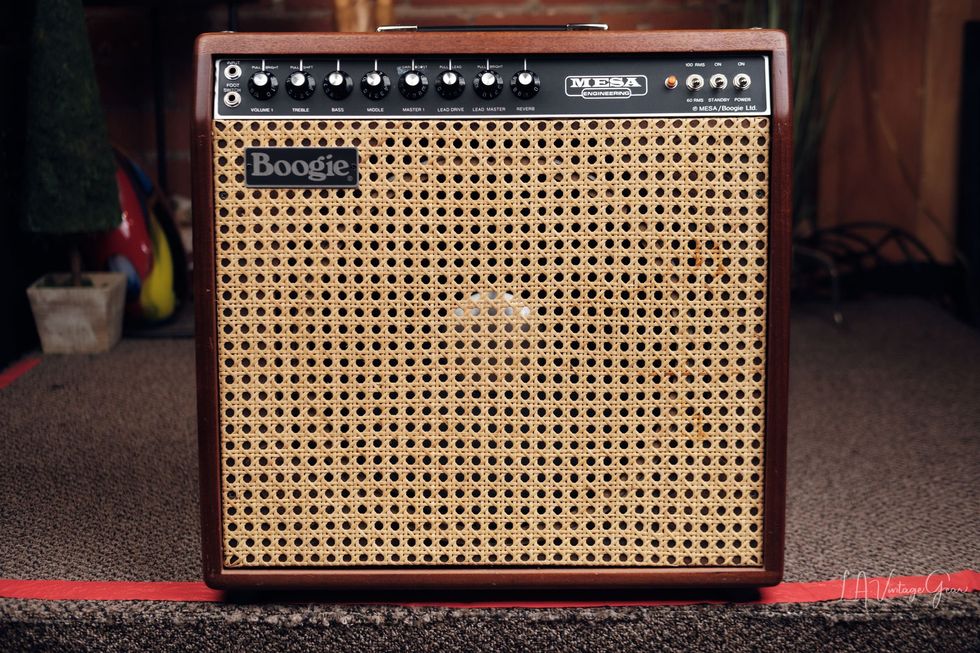
If you get most of your tones from pedals or maybe a multi-effects unit, then you probably won’t need channel switching and you may be best served with an amplifier that has a single channel and a simple control set. In this case, less is more, and the cleanest signal path will give your effects the opportunity to shine. A volume control and some form of tone shaping are all you’ll probably need. A good thing to remember is that many amps that have a lot of front-end gain don’t leave a lot of headroom for pedals. You might want to ask: “Does this amp take pedals well?”
“A tube amp is like a car; occasionally, it will need service.”
Know the difference between gain and volume. A gain control typically controls the amount of gain developed in the front end or preamp section of the amp. This is where most of the overdrive in the amp is developed. The volume control sets the overall loudness of the amp. A low-gain, high-volume setting equals a cleaner tone. A high-gain, low-volume setting equals a more overdriven tone. This is not the only way, however, to get an overdriven sound from an amplifier. Pushing the output tubes into distortion is also an option and has often been done both onstage as well as in the studio. So next….
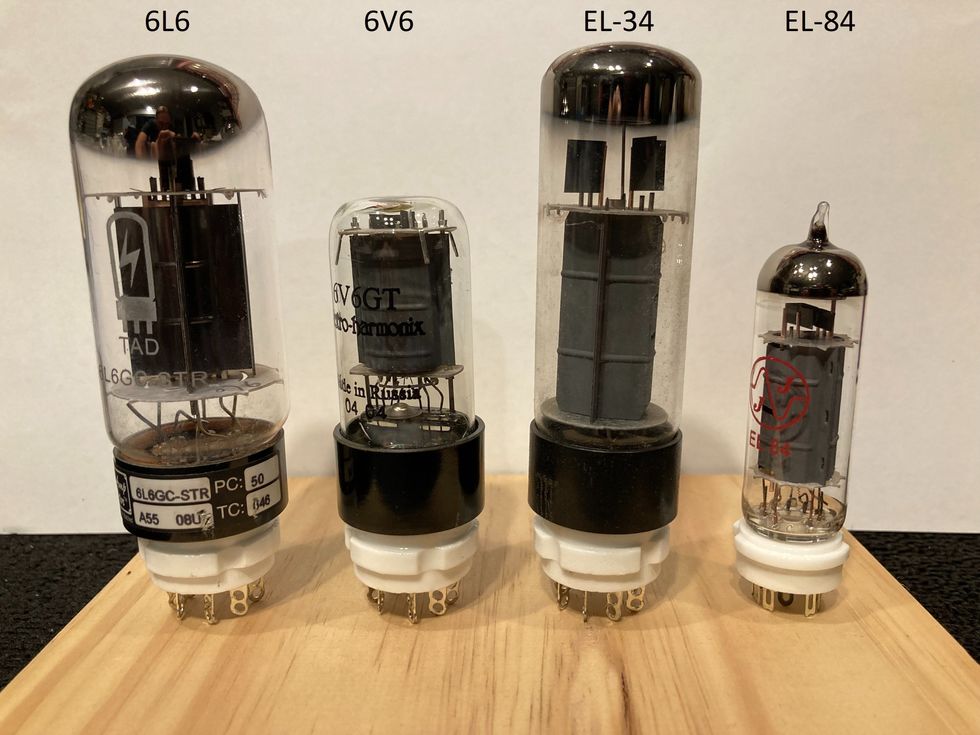
Consider the output power of the amplifier based on where you might be playing it. Most of us, nowadays, don’t need a 100-watt amp, or even a 50-watt amp, to play most venues. I currently play an EAST Duality 30—a 30-watt amp with a half-power mode, and 90 percent of my gigs are done at half power—with a six-piece band with two guitar players. It really doesn’t make sense to pay the increased cost of a 100- or 50-watt amp if you’re never going to need all that power. Tube amplifiers sound the best when the output tubes are being pushed a bit ... or a lot! In fact, many classic solos were done in the studio with a low-powered amp pushed to its limits. Fender tweed Champs and tweed Deluxes seem to shine at this, although there are definitely a few Gibson amps from the ’50s and ’60s that will give them a run for the money! If you happen to encounter a ’50s or ’60s tweed Fender or a Gibson, I would suggest plugging in. Are you gonna get Metallica? No. Are you gonna get Neil Young? All day long! The Fenders of this era have been pretty costly for a while now, but the Gibsons seem to be just catching up. Would these be good as a first amp and give you everything you want? In most instances, no, but as you get some time under your belt as a guitar player, you may appreciate these for what they are. They actually do become another instrument under your control.
“The option of different speaker cabinets with different speakers and configurations can go a long way to tailoring your sound to the gig and venue.”
There is no “best” amp, just the best amp for you! So what output tubes should you consider? Let’s get familiar with the basic types of output tubes first; then we can explore how they’re different. In Photo 1, we see the four basic types of output tubes: 6L6, 6V6, EL34, and EL84. The first two were typically used in the American-produced amps of the ’60s and ’70s. The latter two were their counterparts (more or less) and used in European amps built during this period. After a while, they started to cross pollinate and, especially in the U.S., you could find amps being built with all of these types of tubes. Because of that, you need to take into consideration what type of material you play, as they each have their own tonal characteristics.
If you’re into a classic rock or blues tone, that tone typically has more pronounced midrange content. This, in a broad-stroke kind of way, typically comes from an EL84- or an EL34-based amplifier. These output tubes typically have a more prominent and smooth midrange. If you’re more into hard rock/metal tones, a 6V6- or a 6L6-based amp may serve you better, as these output tubes typically have less midrange content with a more present top and bottom end, making it easier to establish the mid-scoop sound necessary for this music.
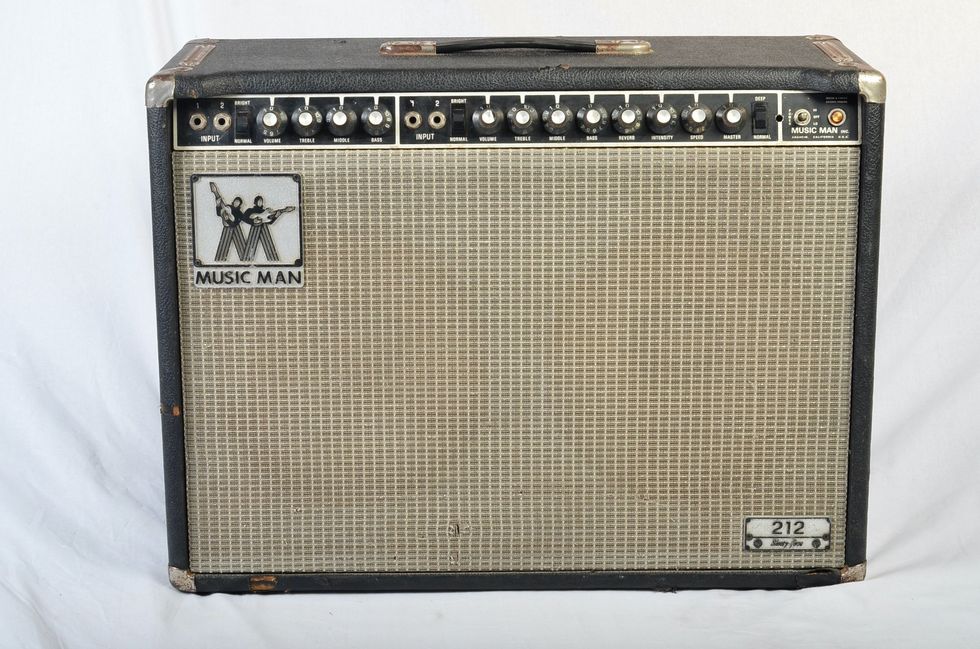
What about hybrid amps? There are some amps out there that only have a tube or tubes in some part of their design. As far as I know, this started with the Music Man line of amplifiers in the ’60s, which had a solid-state front end and a tube output stage. Later, Fender and Marshall started offering amps with one preamp tube in the preamp stage with all other stages of the front end and output stage being solid-state. These amps certainly have less maintenance involved regarding tube replacement and can sound fine if they give you the sound you’re looking for, but personally I don’t categorize these as tube amps.
“An open-back speaker cabinet or combo will tend to fill the area around it with a more ambient type of sound, almost 3-D.”
And speaking of maintenance. A tube amp is like a car; occasionally, it will need service. Output tubes are the tubes that wear out sooner and will need to be replaced more often than preamp tubes. These are the tubes that run the hottest and provide the power to the speaker through an output transformer. Depending on the time of use as well as amount of volume, a typical rule of thumb for replacement of output tubes is six months to two years. That’s not to say that I haven’t seen tubes last 30 years, but if you’re gigging a good bit, you want your amp to be reliable. Another point to be aware of here is that most tube amps will require new output tubes to be biased when installed in the amp. There are exceptions, however. Many amps that use EL84-style output tubes are designed with what’s called cathode bias or self-biasing, where the circuit allows the tubes to find their own bias point. Other amps, such as most Mesa/Boogies, are designed with what’s known as a fixed-bias circuit, so no bias adjustment is possible. This is why they recommend purchasing only their branded output tubes, because they are selected to run within their chosen bias range. Personally, I have seen and serviced many amps with a variable bias control added so that any brand of tube can be properly biased. Either way, your amp may occasionally need a trip to your local experienced tube amp tech for a tube replacement, bias, and overall checkup. It’s worth it to keep it at the top of its game.
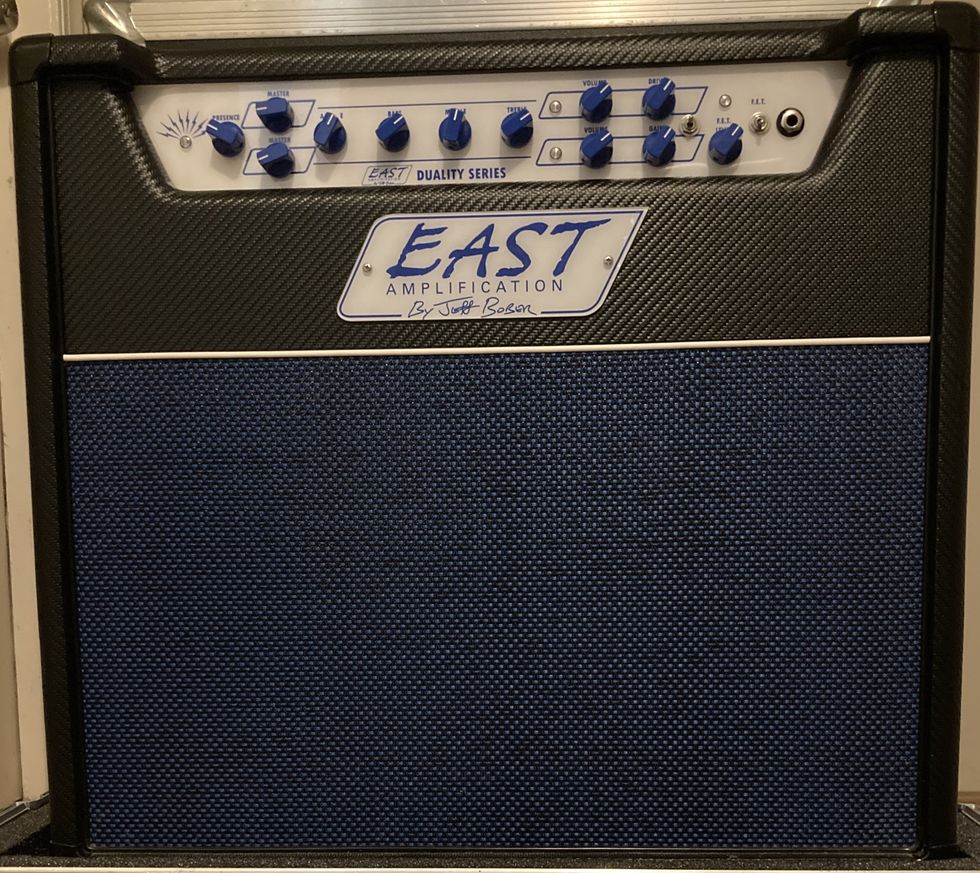
Do you want a head or a combo? A combo is the easiest transportation option. If, say, you live in a city and you believe most of your gigs will require a grab-n-go option, a cab or Uber ride to the gig will be best served with your guitar in one hand and your amp in the other. If, on the other hand, you have the option of packing your own vehicle, you may want to consider a head and cabinet. Having this setup leaves you many options with regard to speakers and cabinets. While the amplifier is substantially responsible for your overall tone, the option of different speaker cabinets with different speakers and configurations can go a long way to tailoring your sound to the gig and venue. One thing to consider here is that because of all the internal vibration that occurs in a combo, it may require more frequent replacement of the tubes. Tubes are, after all, an electro-mechanical device, and vibration can affect their structural integrity.
“If you get most of your tones from pedals or maybe a multi-effects unit, then you probably won’t need channel switching and you may be best served with an amplifier that has a single channel and a simple control set.”
An open- or closed-back speaker cabinet? This choice can go a long way to getting the sound you’re looking for. An open-back speaker cabinet or combo will tend to fill the area around it with a more ambient type of sound, almost 3-D. This is especially great in a lower-powered amp, because it will help fill the stage without being overly loud. These typically don’t have much in the way of low-end sound. If you’re looking for that low-end thud, then you definitely need to focus on a closed-back cabinet. A closed-back cabinet is also much more directional, as all of the sound is coming directly from the front of the cabinet.
To loop or not to loop? Although this pertains to solid-state amps as well, it’s worth addressing here as it applies to tube amps. As I mentioned above, if you get most of your sounds from pedals or multi-effects, then you may not need an effects loop because all your overdrive, fuzz, compression, and time-based units such as chorus, delay, flange, phase, etc., are all hitting your amp through the guitar input on the front panel. If you prefer to get both your clean and overdriven sounds primarily from the amp, then you’re more than likely using a channel-switching amp. In this case, you should definitely look for an effects loop option. The reason being that the sound of time-based units changes drastically when the overdrive channel of an amp is engaged. The extra gain almost always overexaggerates the level of these effects to the point where they become overwhelming. With these types of amps, any of your gain-based units (fuzz, overdrive, compression, boost) can be connected to the guitar input of the amp, but all of your time-based units should be connected through the effects loop. The level of the signal is typically much more consistent here, so the effects levels should not vary much.
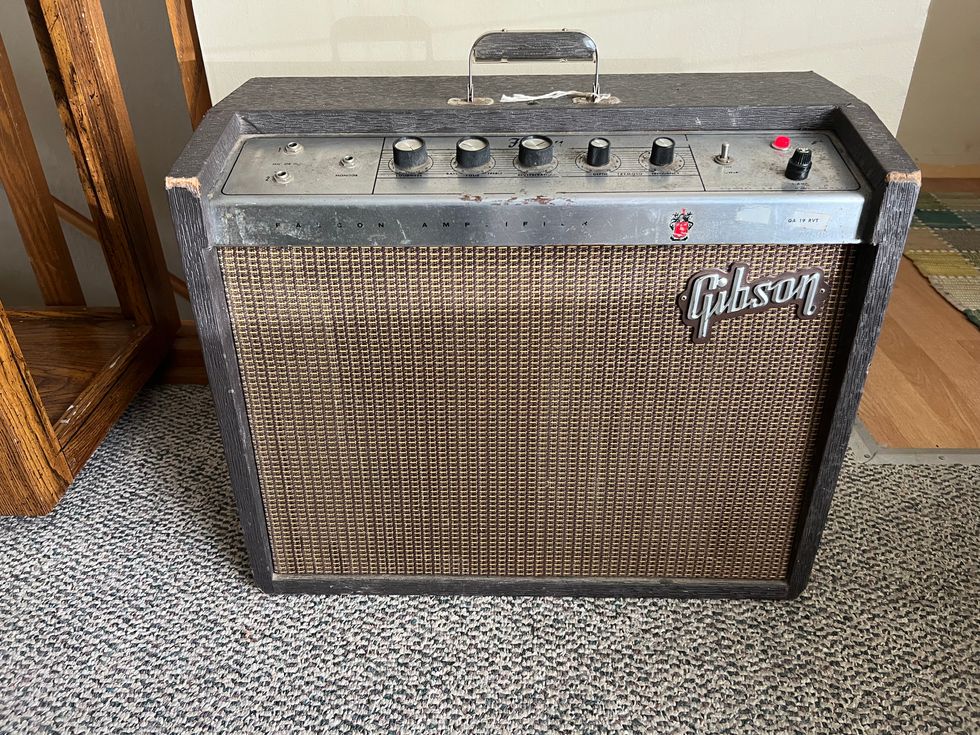
Hand-wired or circuit board? This is a question that you may not have even thought of, and that’s just fine. Some folks may prefer one over the other, so let’s take a minute to explore both. Of course, the first amplifiers ever built were hand-wired because circuit boards did not exist in the ’30s and ’40s. All the resistors and capacitors were soldered directly to a chassis-mounted component or to a chassis-mounted terminal strip. As time went on, eyelet boards and terminal boards were developed so that components could be mounted directly to these boards, and then wire leads would be used to connect these boards to all the chassis-mounted components such as the pots, tube sockets, jacks, etc. This is how all the early Fender and Gibson amps were built. Then came circuit boards, where not only the components were mounted but a good bit of the wiring itself was part of the board in the form of circuit traces, which are actually flat copper wire attached to the board itself. The earliest examples of circuit board amps I can remember were the early ’60s Ampeg amps. Nowadays, most amps are built using circuit-board technology because it can largely be automated, with everything from component placement through soldering being done by machines.
So what’s the difference? Some players feel that a hand-wired amp just sounds better. Some feel they’re more reliable. Some feel that circuit board amps are more consistent from amp to amp because the build is exactly the same each time. All this can be true, but the bottom line is that it’s not all that important. The fact that is important remains if it’s the right amp for you. When you plug into the amp, do you hear what you want to hear? Does it make you want to play? Are you struggling to find a sound, or does it easily get you where you want to be? These are the most important things to ask yourself. Price point is probably next, but if it’s an amp that you really bond with, and it lets you get the sound you hear in your head, then it’s probably the amp for you!
Amp Man’s Guide to Buying a Tube Amp
The longtime author of PG’s popular Ask Amp Man column—and one of the godfathers of the low-power-amp revolution with Budda and then EAST—returns to outline everything you need to know about tracking down the valve-propelled sound machine of your dreams.
In the immortal words of the Byrds:
“So you want to be a rock and roll star? / Then listen now to what I say.
Just get an electric guitar / then take some time and learn how to play.”
But you’re also going to need an amplifier! And if you’re following the Byrds’ protocol, you want a tube amp. These are the amps that voiced all the classic music that made history and still stands the test of time. Finding your ideal tube amp can be a never-ending search, but here are a few tips that may help you get started in your search for tube-amp nirvana.
What do you expect from your amp? Do you want the amp to have a good clean sound as well as the gain you need for solos? If so, then you may want an amp with channel switching, enabling you to footswitch between beautiful clean rhythms and a powerful overdriven solo assault. Some control options to look for here: Does the amp have the ability to alter the tone of the clean and overdrive channels? Sometimes the two channels sound noticeably different, depending on the amp design. Some form of tone control—typically 2- or 3-band EQ—for each channel can help. Also, an added bonus might be a separate master volume control for the clean channel. This would allow you to crank up the gain to give you some nice crunch for your rhythm playing, while setting your overall crunch volume to match the overdrive channel.
If you get most of your tones from pedals or maybe a multi-effects unit, then you probably won’t need channel switching and you may be best served with an amplifier that has a single channel and a simple control set. In this case, less is more, and the cleanest signal path will give your effects the opportunity to shine. A volume control and some form of tone shaping are all you’ll probably need. A good thing to remember is that many amps that have a lot of front-end gain don’t leave a lot of headroom for pedals. You might want to ask: “Does this amp take pedals well?”
“A tube amp is like a car; occasionally, it will need service.”
Know the difference between gain and volume. A gain control typically controls the amount of gain developed in the front end or preamp section of the amp. This is where most of the overdrive in the amp is developed. The volume control sets the overall loudness of the amp. A low-gain, high-volume setting equals a cleaner tone. A high-gain, low-volume setting equals a more overdriven tone. This is not the only way, however, to get an overdriven sound from an amplifier. Pushing the output tubes into distortion is also an option and has often been done both onstage as well as in the studio. So next….

Consider the output power of the amplifier based on where you might be playing it. Most of us, nowadays, don’t need a 100-watt amp, or even a 50-watt amp, to play most venues. I currently play an EAST Duality 30—a 30-watt amp with a half-power mode, and 90 percent of my gigs are done at half power—with a six-piece band with two guitar players. It really doesn’t make sense to pay the increased cost of a 100- or 50-watt amp if you’re never going to need all that power. Tube amplifiers sound the best when the output tubes are being pushed a bit ... or a lot! In fact, many classic solos were done in the studio with a low-powered amp pushed to its limits. Fender tweed Champs and tweed Deluxes seem to shine at this, although there are definitely a few Gibson amps from the ’50s and ’60s that will give them a run for the money! If you happen to encounter a ’50s or ’60s tweed Fender or a Gibson, I would suggest plugging in. Are you gonna get Metallica? No. Are you gonna get Neil Young? All day long! The Fenders of this era have been pretty costly for a while now, but the Gibsons seem to be just catching up. Would these be good as a first amp and give you everything you want? In most instances, no, but as you get some time under your belt as a guitar player, you may appreciate these for what they are. They actually do become another instrument under your control.
“The option of different speaker cabinets with different speakers and configurations can go a long way to tailoring your sound to the gig and venue.”
There is no “best” amp, just the best amp for you! So what output tubes should you consider? Let’s get familiar with the basic types of output tubes first; then we can explore how they’re different. In Photo 1, we see the four basic types of output tubes: 6L6, 6V6, EL34, and EL84. The first two were typically used in the American-produced amps of the ’60s and ’70s. The latter two were their counterparts (more or less) and used in European amps built during this period. After a while, they started to cross pollinate and, especially in the U.S., you could find amps being built with all of these types of tubes. Because of that, you need to take into consideration what type of material you play, as they each have their own tonal characteristics.
If you’re into a classic rock or blues tone, that tone typically has more pronounced midrange content. This, in a broad-stroke kind of way, typically comes from an EL84- or an EL34-based amplifier. These output tubes typically have a more prominent and smooth midrange. If you’re more into hard rock/metal tones, a 6V6- or a 6L6-based amp may serve you better, as these output tubes typically have less midrange content with a more present top and bottom end, making it easier to establish the mid-scoop sound necessary for this music.

What about hybrid amps? There are some amps out there that only have a tube or tubes in some part of their design. As far as I know, this started with the Music Man line of amplifiers in the ’60s, which had a solid-state front end and a tube output stage. Later, Fender and Marshall started offering amps with one preamp tube in the preamp stage with all other stages of the front end and output stage being solid-state. These amps certainly have less maintenance involved regarding tube replacement and can sound fine if they give you the sound you’re looking for, but personally I don’t categorize these as tube amps.
“An open-back speaker cabinet or combo will tend to fill the area around it with a more ambient type of sound, almost 3-D.”
And speaking of maintenance. A tube amp is like a car; occasionally, it will need service. Output tubes are the tubes that wear out sooner and will need to be replaced more often than preamp tubes. These are the tubes that run the hottest and provide the power to the speaker through an output transformer. Depending on the time of use as well as amount of volume, a typical rule of thumb for replacement of output tubes is six months to two years. That’s not to say that I haven’t seen tubes last 30 years, but if you’re gigging a good bit, you want your amp to be reliable. Another point to be aware of here is that most tube amps will require new output tubes to be biased when installed in the amp. There are exceptions, however. Many amps that use EL84-style output tubes are designed with what’s called cathode bias or self-biasing, where the circuit allows the tubes to find their own bias point. Other amps, such as most Mesa/Boogies, are designed with what’s known as a fixed-bias circuit, so no bias adjustment is possible. This is why they recommend purchasing only their branded output tubes, because they are selected to run within their chosen bias range. Personally, I have seen and serviced many amps with a variable bias control added so that any brand of tube can be properly biased. Either way, your amp may occasionally need a trip to your local experienced tube amp tech for a tube replacement, bias, and overall checkup. It’s worth it to keep it at the top of its game.

Do you want a head or a combo? A combo is the easiest transportation option. If, say, you live in a city and you believe most of your gigs will require a grab-n-go option, a cab or Uber ride to the gig will be best served with your guitar in one hand and your amp in the other. If, on the other hand, you have the option of packing your own vehicle, you may want to consider a head and cabinet. Having this setup leaves you many options with regard to speakers and cabinets. While the amplifier is substantially responsible for your overall tone, the option of different speaker cabinets with different speakers and configurations can go a long way to tailoring your sound to the gig and venue. One thing to consider here is that because of all the internal vibration that occurs in a combo, it may require more frequent replacement of the tubes. Tubes are, after all, an electro-mechanical device, and vibration can affect their structural integrity.
“If you get most of your tones from pedals or maybe a multi-effects unit, then you probably won’t need channel switching and you may be best served with an amplifier that has a single channel and a simple control set.”
An open- or closed-back speaker cabinet? This choice can go a long way to getting the sound you’re looking for. An open-back speaker cabinet or combo will tend to fill the area around it with a more ambient type of sound, almost 3-D. This is especially great in a lower-powered amp, because it will help fill the stage without being overly loud. These typically don’t have much in the way of low-end sound. If you’re looking for that low-end thud, then you definitely need to focus on a closed-back cabinet. A closed-back cabinet is also much more directional, as all of the sound is coming directly from the front of the cabinet.
To loop or not to loop? Although this pertains to solid-state amps as well, it’s worth addressing here as it applies to tube amps. As I mentioned above, if you get most of your sounds from pedals or multi-effects, then you may not need an effects loop because all your overdrive, fuzz, compression, and time-based units such as chorus, delay, flange, phase, etc., are all hitting your amp through the guitar input on the front panel. If you prefer to get both your clean and overdriven sounds primarily from the amp, then you’re more than likely using a channel-switching amp. In this case, you should definitely look for an effects loop option. The reason being that the sound of time-based units changes drastically when the overdrive channel of an amp is engaged. The extra gain almost always overexaggerates the level of these effects to the point where they become overwhelming. With these types of amps, any of your gain-based units (fuzz, overdrive, compression, boost) can be connected to the guitar input of the amp, but all of your time-based units should be connected through the effects loop. The level of the signal is typically much more consistent here, so the effects levels should not vary much.

Hand-wired or circuit board? This is a question that you may not have even thought of, and that’s just fine. Some folks may prefer one over the other, so let’s take a minute to explore both. Of course, the first amplifiers ever built were hand-wired because circuit boards did not exist in the ’30s and ’40s. All the resistors and capacitors were soldered directly to a chassis-mounted component or to a chassis-mounted terminal strip. As time went on, eyelet boards and terminal boards were developed so that components could be mounted directly to these boards, and then wire leads would be used to connect these boards to all the chassis-mounted components such as the pots, tube sockets, jacks, etc. This is how all the early Fender and Gibson amps were built. Then came circuit boards, where not only the components were mounted but a good bit of the wiring itself was part of the board in the form of circuit traces, which are actually flat copper wire attached to the board itself. The earliest examples of circuit board amps I can remember were the early ’60s Ampeg amps. Nowadays, most amps are built using circuit-board technology because it can largely be automated, with everything from component placement through soldering being done by machines.
So what’s the difference? Some players feel that a hand-wired amp just sounds better. Some feel they’re more reliable. Some feel that circuit board amps are more consistent from amp to amp because the build is exactly the same each time. All this can be true, but the bottom line is that it’s not all that important. The fact that is important remains if it’s the right amp for you. When you plug into the amp, do you hear what you want to hear? Does it make you want to play? Are you struggling to find a sound, or does it easily get you where you want to be? These are the most important things to ask yourself. Price point is probably next, but if it’s an amp that you really bond with, and it lets you get the sound you hear in your head, then it’s probably the amp for you!



